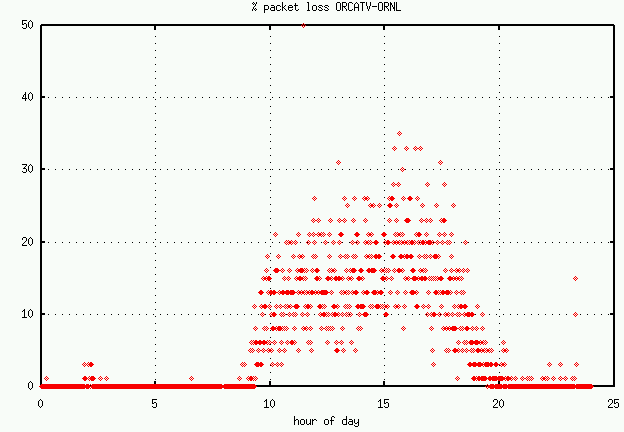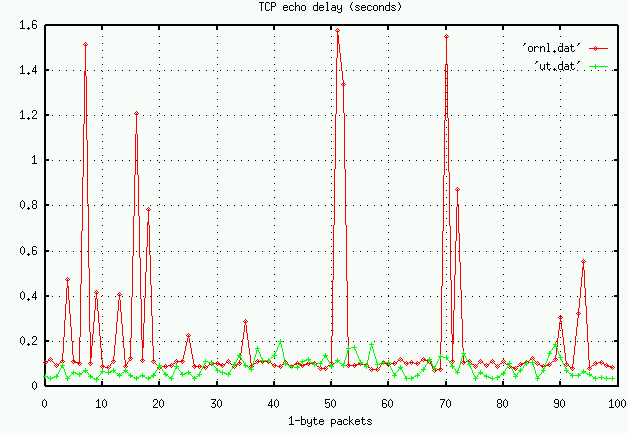 OR Cable Modem ISPchannel tests
OR Cable Modem ISPchannel tests
Various ORNL staff members participated in test and evaluation of this
data service starting in July, 1998.
This page summarizes our experiences.
Configuration
OR CATV uses the Terayon Terapro
cable modem.
The book-size modem
connects to a standard cable TV drop and provides a 10BaseT (RJ45)
Ethernet connection for your home computer.
The modem is capable of 14 Mbits/sec full-duplex (7 Mbits/sec in each
direction), but can be configured (by the network manager) to run
at lower data rates.
Presently, OR CATV is connected to the Internet by a T1 (1.544 Mbits/sec)
circuit.
Data services have been subcontracted to
ISPchannel.com.
You should contact OR CATV for the current information and/or
vist ISPchannel.com
but it is my understanding that the rate is $30/month (over and
above your current CATV subscription) for a
DHCP
(dynamic) IP address,
an email addresses, and 10 Mbytes of disk space.
There is a $99 installation fee, plus you need an Ethernet card
for your home computer, and $350 for the cable modem, or lease for $10/month.
The cable modem is configured for 512 Kbits/sec inbound and
128 Kbits/sec outbound.
Though Ethernets are normally "party-lines" and subject to eavesdropping,
the OR CATV configuration permits your cable modem to see only traffic
destined to your home computer and no one else's traffic.
However, as with any ISP, your network packets travel through many sites,
so you should assume someone could be reading your packets along the way.
There are various products (ssh,
pptp,
pgp) that one might use
to insure privacy.
Performance
We used both Windows95/NT boxes and Linux boxes to evaluate the
performance and reliability of the OR CATV data service.
We used both static and dynamic (DHCP) IP addresses.
We also attached an Ethernet hub to the cable modem and connected
multiple computers to the network.
The cable modems were configured at various data and packet rates
during the test period.
We performed bandwidth and latency tests between computers on the CATV network
and with computers across the Internet.
Early on, we experienced some packet loss on the reverse channel (outbound
from home), but these problems were corrected.
The route from OR CATV data network to ORNL is quite circuitous, passing
through some 13 routers via Washington DC and Atlanta
(see traceroute below).
traceroute to sgb (208.234.82.225), 30 hops max, 40 byte packets
1 134.167.15.1 (134.167.15.1) 0.601 ms 0.472 ms 0.44 ms
2 x10gwy.ens.ornl.gov (128.219.0.1) 16.38 ms 2.177 ms 1.849 ms
3 orgwy.ctd.ornl.gov (198.124.42.1) 3.488 ms 3.412 ms 2.945 ms
4 ornl-rt3f0.ctd.ornl.gov (192.31.96.75) 3.343 ms 2.485 ms 3.256 ms
5 dcconn-atms.es.net (134.55.24.16) 225.352 ms 27.411 ms 27.093 ms
6 br2.tco1.alter.net (192.41.177.249) 69.191 ms 81.689 ms 47.342 ms
7 112.ATM2-0.XR1.TCO1.ALTER.NET (146.188.160.82) 34.948 ms * 64.139 ms
8 193.ATM2-0.TR1.DCA1.ALTER.NET (146.188.161.162) 33.714 ms 59.595 ms 55.494 ms
9 * 101.ATM6-0.TR1.ATL1.ALTER.NET (146.188.136.13) 77.241 ms 91.16 ms
10 199.ATM6-0.XR1.ATL1.ALTER.NET (146.188.232.81) 91.213 ms 60.085 ms 88.448 ms
11 195.ATM8-0-0.GW1.ATL1.ALTER.NET (146.188.232.33) 88.287 ms 62.445 ms 83.14 ms
12 208.236.101.97 (208.236.101.97) 113.703 ms 78.549 ms 84.449 ms
13 catvrtr (208.234.82.1) 72.805 ms 89.096 ms 73.537 ms
14 sgb (208.234.82.225) 104.093 ms 104.006 ms 116.01 ms
Some of these intermediate hops can be quite congested resulting
in packet loss (often as much as 50%).
The following graph shows percent packet loss between ORNL and home via
the CATV route for a 24 hour period during the week.
Data is collected each minute from 60 ICMP ping packets.

If you're telneting into ORNL from home, this long lossy route
can cause annoying "echo delays".
(Most of the losses are occuring at the entry-point of the Internet
into DOE's ESnet, so other ISPs might experience the same losses.)
By contrast, the route to UT is only 4 hops.
(As of May, 1999, the UT route is now 14 hops, but not as lossy as
the route through ESnet to ORNL.)
The following graph compares the TCP echo delay (in seconds)
for 100 1-byte packets
between home and UT (ut.dat, 4 hops) and home and ORNL (ornl.dat).
During this weekday test, echo delay is often more than a second.

Such loss also reduces bandwidth for http/ftp transfers.
For example, during a 5% loss period to ORNL, ORNL data rate to home
was 373.774 Kbits/sec, but the UT-to-home rate was 1099.44 Kbits/sec.
During 0 loss periods, ORNL-to-home data rates are 1100 Kbits/sec.
In discussions with ISPchannel, we suggested they consider providing
a more direct route to ORNL, perhaps through
rite.org as other local ISPs have done.
Roundtrip latency between computers on the CATV net was about 48 ms, to UT about
53 ms, and to ORNL about 90 ms (with longer times during congestion).
Bandwidth depended on the settings of the cable modem, but we were able
to receive data at full T1 speeds.
During our tests, outbound (from home) data rate was about 240 Kbits/second.
The maximum outbound
packet rate is configured at 300 packets/second.
Broadcast and multicast packets are not passed by the cable modems,
so services based on those protocols will not work.
We did not evaluate any of the higher level services (email, etc).
 OR Cable Modem ISPchannel tests
OR Cable Modem ISPchannel tests OR Cable Modem ISPchannel tests
OR Cable Modem ISPchannel tests
